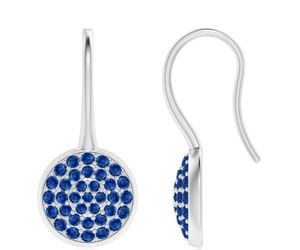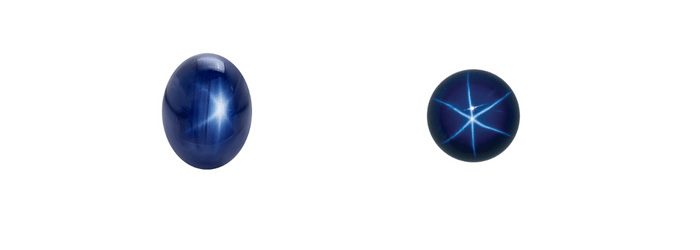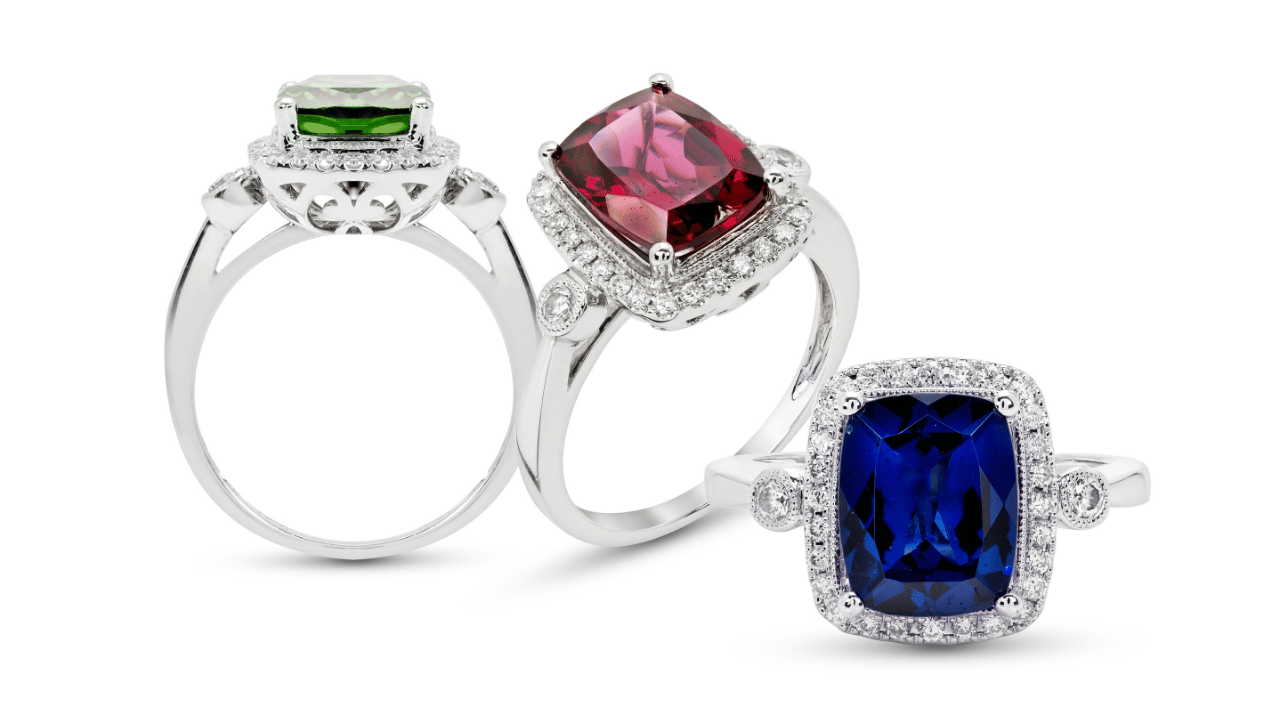The beauty of Mother Nature's colored gemstones is mesmerizing, from their original crystal forms to the faceted gemstones.

In our Colored Gemstone Library, we strive to provide information that will give you gemological properties and interesting facts about your favorite gems. Continue on for more about the mineral species corundum and one of the most important varieties Blue Sapphire.

BLUE SAPPHIRE
Are you a gemstone enthusiast looking to learn more about one of the most coveted stones in the world?
Look no further than blue sapphire, a variety of corundum. This beautiful gem is known for its deep blue hue and has been used for centuries in jewelry and other decorative items.
Let’s take a closer look at this stunning gemstone!
History of Blue Sapphire

When it comes to precious gemstones, there is no shortage of choices. But one in particular stands out above the rest—blue sapphire. This gorgeous stone, part of the corundum family, has been used in jewelry for centuries and is still a favorite choice today, especially for engagement rings!

Let’s take a closer look at why blue sapphire is so special.
Probably one of the most famous blue sapphires was presented to Princess Diana upon her engagement to the present king of England, King Charles III. That ring, a 12-carat oval Ceylon blue sapphire, is currently the engagement ring worn by the Duchess of Wales, Katherine.
It is also featured prominently in most royal jewelry collections around the world. And, if you are lucky enough to be born in September, blue sapphire is your stone.
DESCRIPTION:
Blue sapphire is composed of aluminum oxide and traces of iron and titanium which give it its characteristic blue color.
Its hardness makes it ideal for use in jewelry since it can withstand wear and tear over time without losing its luster or color.
It measures 9 on the Mohs scale, making it one of the hardest natural materials available today.

LORE:
Blue sapphire has been valued as a precious jewel since ancient times. In Sanskrit writings from 1500 BC, blue sapphire was referred to as “neelam” meaning “the blue stone” and was thought to bring peace and prosperity to its wearer.
Ancient kings crafted intricate pieces of jewelry with this beautiful gemstone, which also held spiritual significance for them.
Today, many cultures around the world associate blue sapphires with love, fidelity and protection against evil forces.

Blue sapphires can be found all over the world, but some areas have become especially well known for producing high-quality gems.
India has long been considered one of the best sources for blue sapphires due to its large number of mines as well as its distinctive “Kashmiri” hue which makes them particularly valuable.
Sri Lanka is another major source; many experts believe that these stones possess a unique depth and clarity not found anywhere else on earth.

Gemstone Specifics:
SPECIES: Corundum-Variety-Blue Sapphire
CRYSTAL HABIT: Trigonal
CHEMICAL FORMULA: Al2O3 Aluminum Oxide + Fe, V
COLOR RANGE: Very light to very dark violetish blue-to greenish blue
CAUSE OF COLOR: Iron and Titanium
SOURCES INCLUDE: India and Kashmir Myanmar Madagascar Thailand Australia U.S. (Montana) Sri Lanka (Prized "Cornflower Blue")
ACCEPTABLE ENHANCEMENTS: Heated to improve color and clarity.
HARDNESS: 9
TOUGHNESS: Excellent
CARE: Basic jewelry care: mild liquid soap, warm water and soft brush.
Did You Know?
The finest blue sapphires, from Kashmir, have unique "snowflake" shaped inclusions, where fine silk needles cross each other. The only location that produces blue sapphires that features these internal characteristics.
When these inclusions are found intact, it means the stone was not subjected to heat treatment (extremely rare that sapphires are not heated treated) and also identifies the country of origin as Kashmir.
These two facts put Kashmiri sapphires into the category as one of the rarest and most expensive gems in the world.
Did You Know?
Corundum, due to its hardness ranking, has important industrial purposes: drilling and cutting tools, and right down everyday items such as your nail file and sandpaper.
In Conclusion:
As you can see, there are many reasons why people love wearing blue sapphire jewelry!
With its timeless beauty, durability and rich history, it’s no wonder this precious stone has stood the test of time as one of the most sought-after jewels in the world today.
Whether you decide on a stunning ring or sophisticated necklace set with this stunning gemstone, you can be sure your piece will last for generations!
So if you’re looking for something special that will make heads turn wherever you go—go with a beautiful piece featuring blue sapphires! Be sure to take a look at all the pieces we've featured above by clicking the links to Angara.com.
FAQs
Do sapphires come in other colors?
Normally when people hear the word sapphire, they immediately think of blue sapphire.
Corundum, the mineral species that includes blue sapphires actually comes in a whole host of colors, starting with colorless sapphire.
In addition you will find: purple, green, pink, violet, yellow or golden, orange, brown and black the full range of rainbow colors.
Any color other than blue, or ruby are referred to as fancy sapphires.
Ruby (red corundum) and the exotic Padparadscha sapphire (pink-salmon) are the only two that have their own names.
What is a "star-sapphire"?
Star-sapphires are stones that reflect a star pattern over the surface of some cabochon-cut sapphire (and rubies).
Gemstones that exhibit special optical features are called phenomenal gemstones.
In the case of star-stones (the gemological term is asterism) the stars are caused by rutile needle inclusions that reflect light in a star pattern if the stone is cut to create a star.
The star will float across the surface of the stone as the light source moves.

Linde Star blue sapphires were first produced by Union Carbide in the 1940s. They can be identified by the perfect stars on the surface, with the legs of the star extending down to the base and a small "L" printed on the bottom of the stone.
The required cutting style of stones exhibiting asterism is "en cabochon" a high dome.
What is the largest blue sapphire ever found?
The largest faceted blue sapphire: 486.52 carats-The Giant Blue-mined in Sri Lanka (Ceylon) in 1907.
The largest cabochon cut blue sapphire displaying asterism: 1404 carats-The Star Of Adam, mined in Sri Lanka in 2015. Forbes estimated the value at $3 million.
What are the best blue sapphires?
Sapphires mined high in the Himalayan Mountains of Kashmir, northern India, have always been the most prized, due to the combination of their color and beautiful internal velvety texture.
That texture, caused by the snowflakes and fine silk (as described above) is not found in any other sapphires.
The supply has always been limited, due to the remote location and severe weather conditions six months' of the year.
Unfortunately the deposit is now depleted, so existing stones confirmed as Kashmiri are extremely rare and valuable.
Additional Articles You May enjoy :


If you are interested in the healing and motivational powers of crystals, I recommend checking out Creative Chronicles.com
Thank you for reading our article; please leave your comments and questions below.
Happy Shopping!
Francesca de Granville, G.G. (GIA) F.G.A.
If you like, read our full Affiliate Disclosure






Member discussion